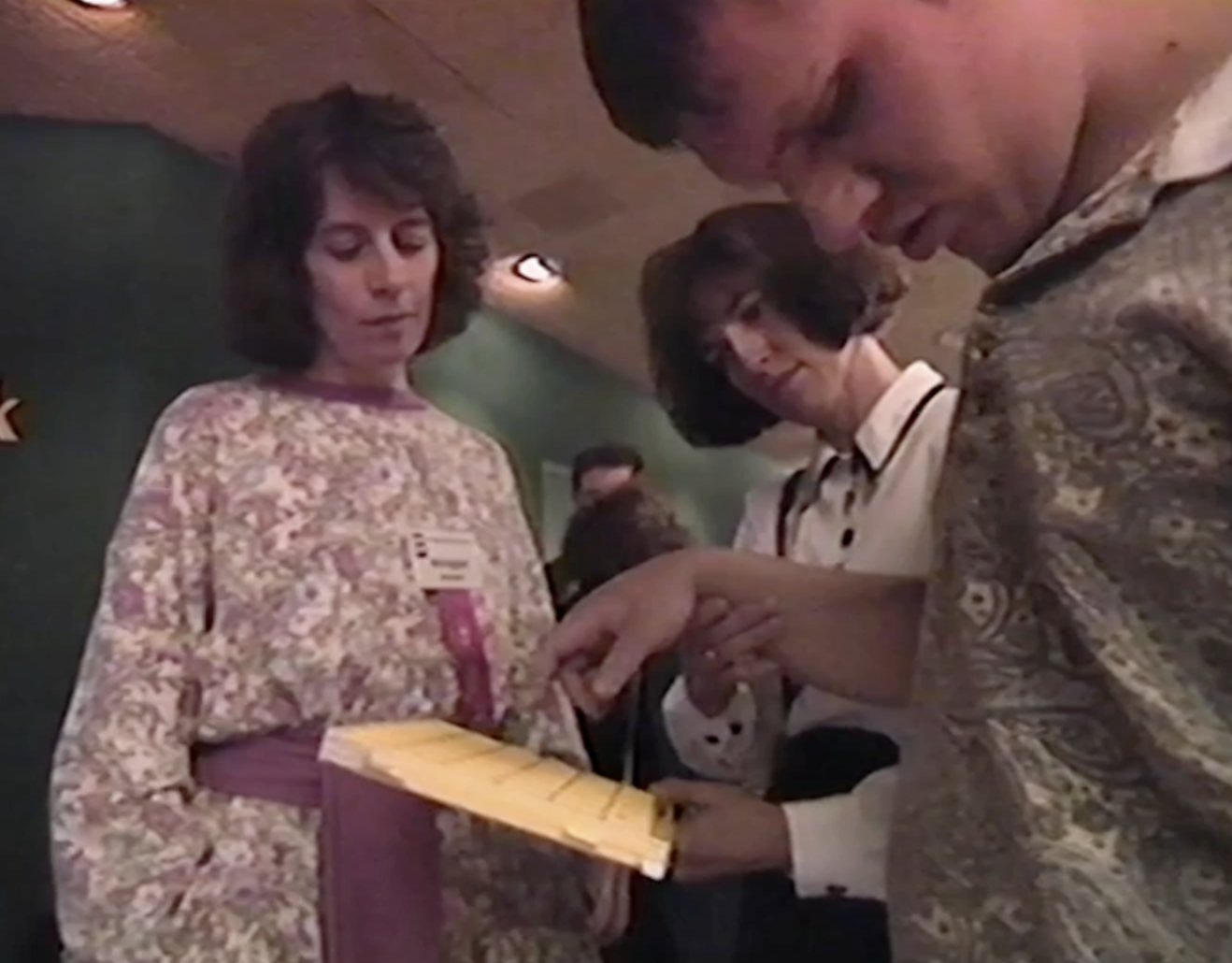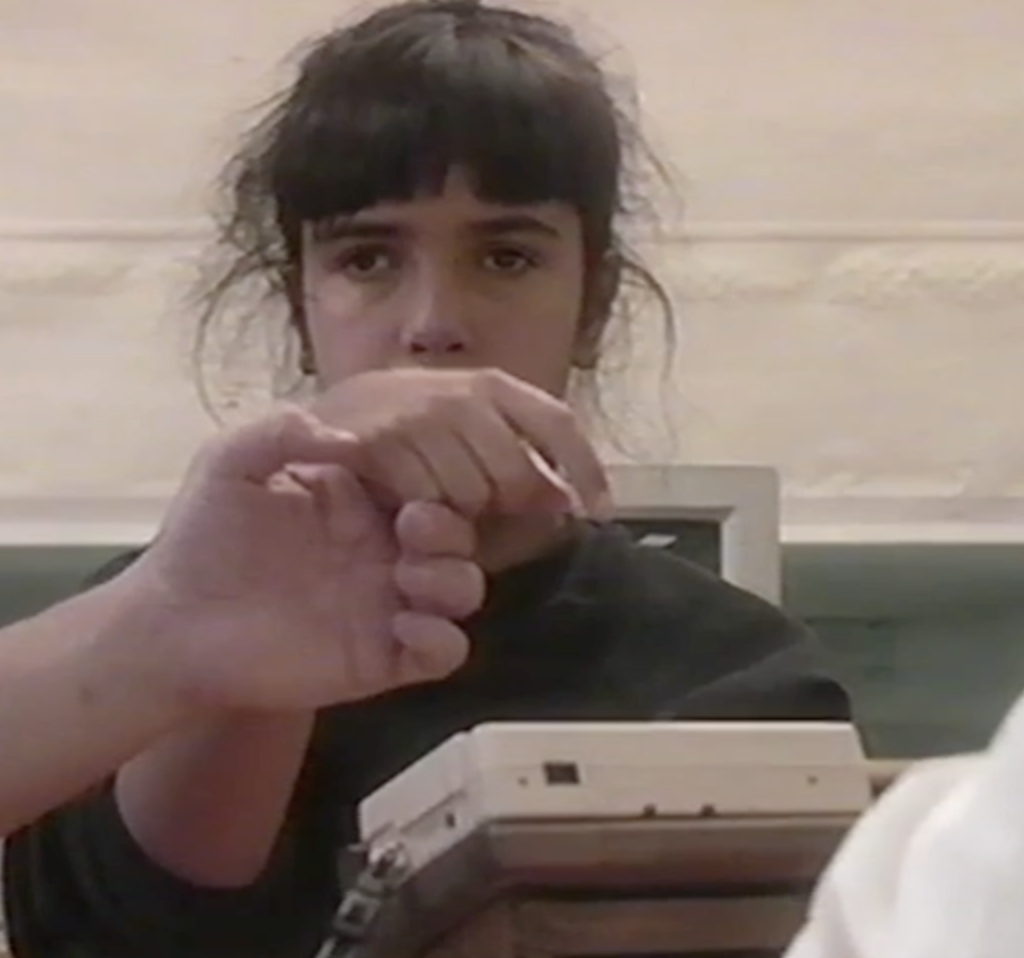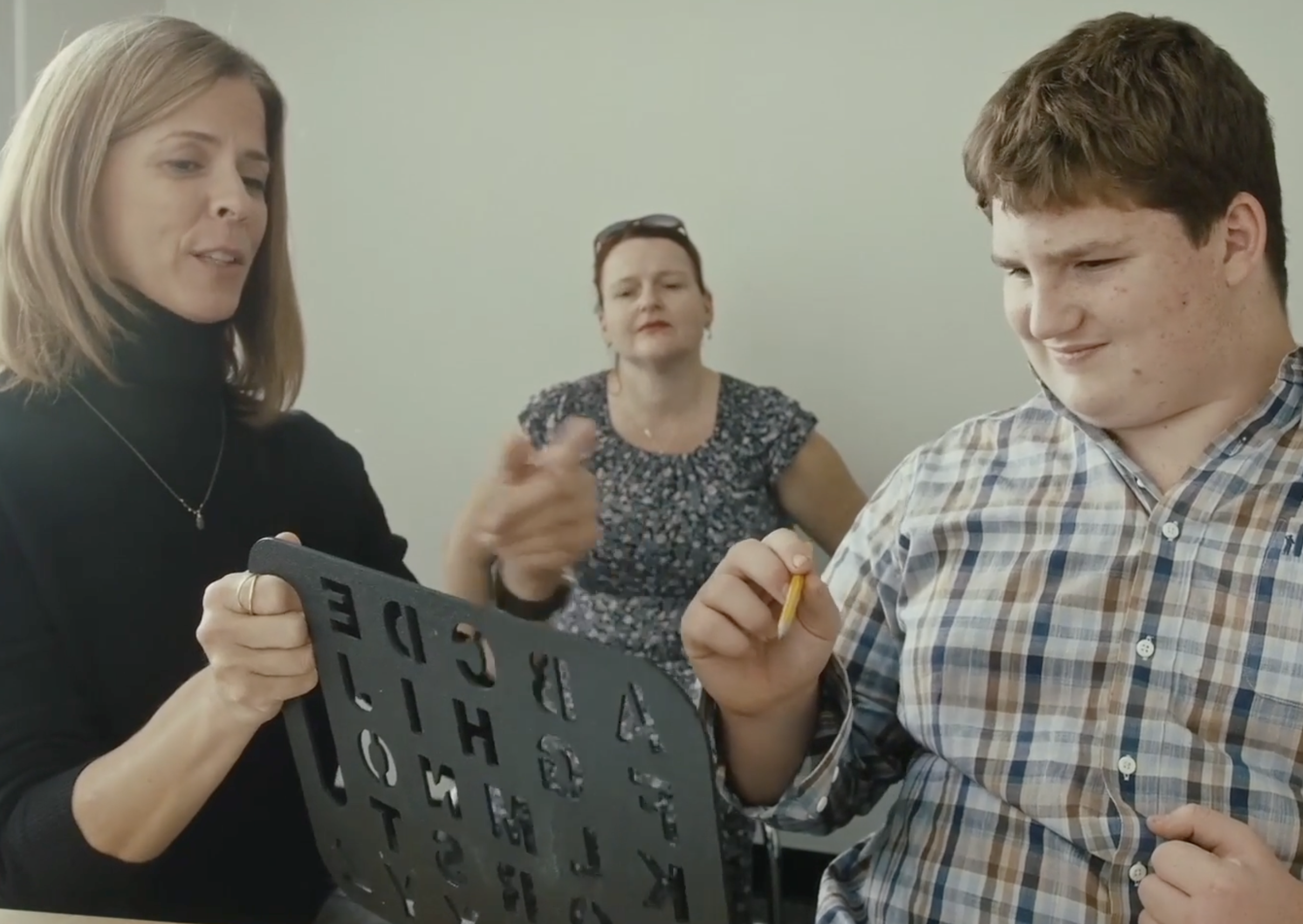The “evolution” of FC: Making FC look more convincing
Today’s blog post is a continuation of a series I started in response to a reader’s question: How has Facilitated Communication (FC) changed since the early 1990s? In previous blog posts (links below), I discussed themes from the 1993 documentary Prisoners of Silence. By comparison, I turn my attention to the 2023 film Spellers. I’m resisting calling Spellers a documentary, since the movie is devoid of any significant criticisms of FC. In her review of the film, Katharine called Spellers a “documercial” for a variant of FC called Spelling to Communication (S2C). I agree.
Individuals with their facilitators at a screening for the film Spellers (Spring 2023, TheHighWire)
FC proponent Dawnmarie Gaivin (one of the facilitators featured prominently in Spellers) seems to be in the process of rebranding FC/S2C to the “spellers’ method.” This practice of rebranding of FC is not new. Since we started this website, we’ve collected over 20 different names for FC used in the press and on social media sites and the list keeps growing. It is no wonder people new to the world of FC are confused by the terms.
Basically, we can divide FC into two subcategories (with FC as the umbrella term for all facilitator-dependent techniques):
1) Touch-based FC. This is the form of FC used by “inventor” Rosemary Crossley of Australia and Syracuse University’s Facilitated Communication Institute (FCI) founder Douglas Biklen.* With touch-based FC, the facilitator holds onto their client’s or loved one’s wrist, elbow, shoulder, or other body part during letter selection. Facilitators may also hold onto the person’s shirt sleeve or shirt tail to provide physical feedback (cueing). Often, but not always, the letter board is placed on a stable surface for letter selection.
Touch-based FC is also known as supported typing, saved by typing, hand-over-hand, to name just a few. (For a more complete list, please see the home page of our website).
Here are still images of FC from Prisoners of Silence:
2) Limited or no-touch FC. This is a form of FC most often credited to Soma Mukhopadhyay. According to Portia Iversen in her book Strange Son, Mukhopadhyay started out using touch-based FC with her son, Tito, but decided to vary the technique after she failed a simple blind test set up by her husband. I’ve written about this in a previous blog post, so won’t go into detail here. Broadly speaking, with this style of FC, the facilitator holds a letter board or stencil in the air while the individual being subjected to it extends a finger toward it. Limited or no-touch FC is known as Rapid Prompting Method (RPM), Spelling to Communicate (S2C), and Informative Pointing to name just a few. (For a more complete list, please see the home page of our website). The film Spellers features this form of FC, as seen in the still images below.
By the mid-1990s, the scientific community had, essentially, debunked FC. If you read the controlled studies (or watch the O.D. Heck facilitators discuss FC in Prisoners of Silence) you’ll discover that, contrary to proponent claims today, the “scientists”—or rather psychologists and Speech/Language Pathologists in most cases—involved with conducting authorship studies wanted FC to work or they were at least open to the possibility that it could work. Many of the participants—especially in the earlier studies—were already using touch-based FC and thinking their clients or loved ones were communicating their thoughts. Researchers picked their most successful facilitator-client pairs to participate in the testing (e.g., those with experience using the technique who were producing FCed communications at the word and/or sentence level). (See controlled studies) But, the problem was that when the facilitators were blinded to test protocols and/or prevented from seeing the letter board, the FC-generated answers consistently fell into three different categories: 1) unintelligible, 2) correct, but based on information provided to the facilitator and not to the individual being subjected to FC, or 3) correctly spelled but inconsistent with the topics being discussed (e.g., facilitator guesses). Much of the discussion in the early days of FC centered around the question: Who’s doing the pointing? This referred to the physical supports provided by facilitators (e.g., the facilitators held onto the person’s wrist, elbow, shoulder, or other body parts). A better question to ask of FC (regardless of type) is “Who is controlling letter selection?”
Double-blind testing of FC conducted at the O.D. Heck Center (Prisoners of Silence, 1993)
Proponents of FC (then as they do now) rejected all reliably controlled authorship tests, claiming that testing broke the facilitator/client “trust bond” and that participants were too nervous to answer correctly under “adverse” conditions (weirdly blaming the participants for FC’s faults). But, as the narrator in Prisoners of Silence noted:
…researchers asked, was it possible that a child who can write poetry and do algebra be unable to label a cup? And they questioned why autistic individuals who had appeared on national television and addressed crowds at Syracuse conventions would all be so nervous that none of them would get a single answer right.
After Prisoners of Silence exposed the deep flaws in FC, some facilitators (loyal to Biklen and Syracuse University’s FCI/ICI) stayed true to the “traditional” touch-based form of FC, but stayed more-or-less out of the public eye. This strategy seemed to be deliberate, as John Hussman, a major donor for the FCI, indicated in a 2015 New York Times article:
“We need to do more on FC, but we can’t call it that…We have to come up with some other name to fly under the radar and maintain credibility.” (Engber, 2015)
I think that’s part of the reason many people thought FC died out.
A facilitator holds a stencil in the air while the individual points to letters. (Spellers, 2023)
But a certain number of facilitators responded to the question “Who’s doing the pointing?” by developing a variation of FC that makes it look more convincing (at least to some people). These facilitators reasoned that if they held the board in the air and the person being facilitated independently pointed to the board, then that would solve the problem of facilitator cueing. As I noted earlier, Soma Mukhopadhyay was one of these facilitators. Portia Iversen (a devoted fan of Mukhopadhyay) and, later, Tracy Kedor (See my review of Ido in Autismland) also developed systems similar RPM. Elizabeth Vosseller (“inventor” of S2C) trained under Mukhopadhyay and Gaivin (“inventor” of the speller’s method) seems to have ties with Vosseller. But looks can be deceiving and like with touch-based FC, none of the limited or no-touch forms of FC adequately address the problems of facilitator cueing and control of letter selection, prompt dependency, or authorship. Current day facilitators either don’t know or don’t seem to care about the problems of cueing and facilitator interference during letter selection in limited or no-touch forms of FC.
I’ll continue exploring the problem of cueing and Spellers in my next installment.
References:
Engber, Daniel. (2015, October 25). The Strange Case of Anna Stubblefield. New York Times.
Wheeler, DL, Jacobson, JW, Paglieri, RA, and Schwartz, AA. (1993). An experimental assessment of facilitated communication. Mental Retardation. Vol 31 (1), 49-60. [O.D. Heck study]
Select blog posts related to this topic:
A long history of derision and embarrassment for Syracuse University’s support of FC
FC/S2C/RPM and False Allegations of Abuse
Reaction to a 1994 article I wrote about my experiences with FC
Response to reader question: Has FC changed since the early 1990s - Part 1
Response to reader question: Has FC changed since the early 1990s - Part 2
Strange science in Iversen’s book “Strange Son”
Truth will out: review of Portia Iversen’s “Strange Son”

































